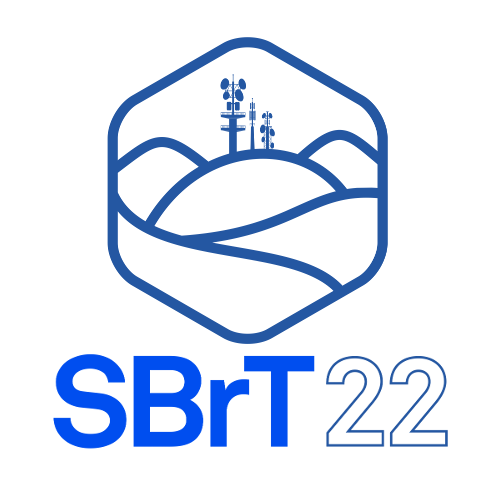
XL Simpósio Brasileiro de Telecomunicações e Processamento de Sinais
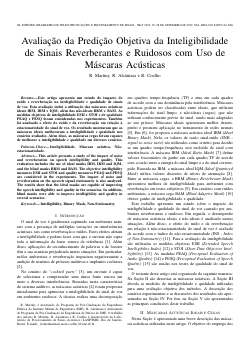
Avaliação da Predição Objetiva da Inteligibilidade de Sinais Reverberantes e Ruidosos com Uso de Máscaras Acústicas
Rafael Martiny, Raoni Alcântara, Rosângela Coelho
DOI: 10.14209/sbrt.2022.1570823642
Keywords: Inteligibilidade Máscara acústica Não-estacionariedade
Abstract
This article presents a study of the impact of noise and reverberation on speech intelligibility and quality. This evaluation includes the use of ideal masks IBM, IRM and IQM, and the blind masks BRM and BAM. The objective intelligibiliry measures ESII and STOI and quality measures PEAQ and PESQ are considered in the experiments. The impact of noise and reverberation on the speeech signal stationarity is also analyzed. The results show that the ideal masks are capable of improving the speech intelligibility and quality in the scenarios. In addition, blind masks were able to improve intelligibility and quality in several scenarios.Download
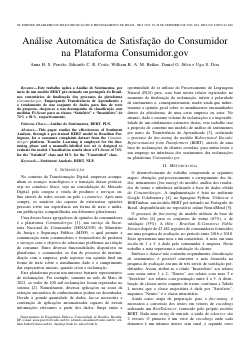
Análise Automática de Satisfação do Consumidor na Plataforma Consumidor.gov
Daniel G Silva, Ugo Dias, Anna Beatriz de Souza Perotto, William Batista Aguiar Motta Betker, Eduardo Rocha da Costa
DOI: 10.14209/sbrt.2022.1570823709
Keywords:
Abstract
This paper studies the effectiveness of Sentiment Analysis, via the BERTimbau language model, for a consumer complaints dataset from the Consumidor.gov platform. Transfer Learning is employed for the finetuning phase and a manually-labelled test set is designed to evaluate the model. Classification results show a F1-Score of 74% for the "Satisfied" class and 81% for the "Unsatisfied" class.Download

Design, Application, and Validation of an IoT Wireless Sensor Network based on Lora for Strawberry Farming
Mateus R Cruz, Samuel Mafra, Felipe Augusto Pereira de Figueiredo
DOI: 10.14209/sbrt.2022.1570823724
Keywords: Internet of Things LoRa Machine Learning Wireless Sensors
Abstract
Agriculture innovation has become essential to increasing the efficacy of food production. Wireless Sensor Networks and the Internet of Things can play an essential role in this innovation process. This paper proposes and validates a LoRa network that applies Machine Learning capabilities on edge following an Internet of Things approach. The Wireless Sensor Network proposed combines Long Range communications and monitoring systems, allowing a data-driven farming approach. It is essential in a world with a crescent population and limited plantation area.Download
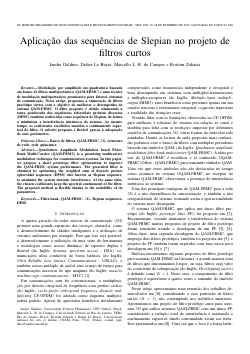
Aplicação das sequências de Slepian no projeto de filtros curtos
Iandra Galdino, Didier Le Ruyet, Marcello Campos, Rostom Zakaria
DOI: 10.14209/sbrt.2022.1570823731
Keywords: Filter-bank QAM-FBMC Slepian sequences DPSS
Abstract
Quadrature Amplitude Modulation based Filter-Bank Multi-Carrier (QAM-FBMC) is a promising multicarrier modulation technique for communication systems. In this paper, we propose a short prototype filter optimization to improve the QAM-FBMC system performance. The presented filter is obtained by optimizing the weighted sum of discrete prolate spheroidal sequences (DPSS) also known as Slepian sequence, to minimize the system intrinsic interference. At the same time, the chosen coefficients keep the spectral confinement of the filter. The proposed method is flexible thanks to the suitability of its parameters.Download
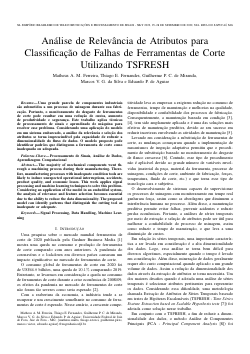
Análise de Relevância de Atributos para Classificação de Falhas de Ferramentas de Corte Utilizando TSFRESH
Matheus A. M. Ferreira, Thiago E. Fernandes, Guilherme P. C. Miranda, Marcos V. G. Silva, Eduardo Pestana de Aguiar
DOI: 10.14209/sbrt.2022.1570823732
Keywords: Processamento de Sinais Análise de Dados Aprendizagem Computacional
Abstract
The majority of mechanical components went through a machining process during their manufacturing. Therefore, manufacturing processes with inadequate condition tools are likely to induce unexpected operational interruptions, accidents, product quality, and economic losses. Accordingly, the ability to classify fault imminences can result in cost reduction, along with productivity and safety increase. This paper applies digital signal processing and machine learning techniques, to solve this problem. The model proposed in this work achieves satisfactory performances in all cases and prevents fault occurrences.Download
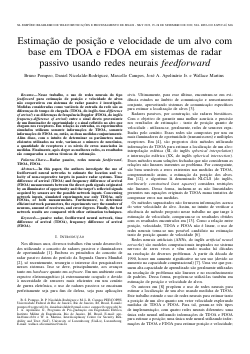
Estimação de posição e velocidade de um alvo com base em TDOA e FDOA em sistemas de radar passivo usando redes neurais feedforward
Bruno Pompeo, Daniel Nicolalde Rodríguez, José Antonio Apolinário Jr., Marcelo Campos, Wallace Alves Martins
DOI: 10.14209/sbrt.2022.1570823738
Keywords: passive radar feedforward neural network time difference of arrival frequency difference of arrival
Abstract
In this paper, the authors investigate the use of feedforward neural networks to estimate the location and velocity of non-cooperative targets in passive radar systems. Time difference of arrival (TDOA) and frequency difference of arrival (FDOA) measurements between the direct-path signals originated by an illuminator of opportunity and the target's reflected signals acquired by sensors are the possible network inputs. Concerning network inputs, simulated experiments use only TDOAs, only FDOAs, or both measurements. Furthermore, to determine efficient network parameters, the experiments vary the number of neurons, amount of receivers, and error degrees. Finally, the best network results are compared with other estimation techniques.Download
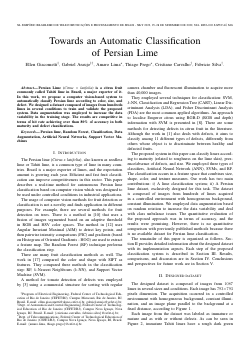
Towards an Automatic Classification of Persian Lime
Ellen M Giacometti, Gabriel Araujo, Thiago Prego, Amaro de Lima, Cristiano de Carvalho, Fabrício Silva
DOI: 10.14209/sbrt.2022.1570823756
Keywords: Random Forest Classification Persian lime Data Augmentation
Abstract
Persian Lime (Citrus × latifolia) is a citrus fruit commonly called Tahiti lime in Brazil, a major exporter of it. In this work, we propose a computer vision-based system to automatically classify Persian lime according to color, size, and defect. We designed a dataset composed of images from hundreds limes in several conditions to train and validate the proposed system. Data augmentation was employed to increase the data variability in the training stage. The results are competitive in terms of hit rate achieving over than 80% of accuracy in both maturity and defect classifications.Download
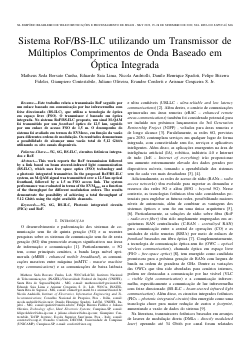
Sistema RoF/BS-ILC utilizando um Transmissor de Múltiplos Comprimentos de Onda Baseado em Óptica Integrada
Matheus Sêda, Eduardo Saia, Nicola Andriolli, Danilo Spadoti, Felipe Bizerra Fideles, Giampiero Contestabile, Juliano Oliveira, Evandro Conforti, Arismar Cerqueira S. Jr.
DOI: 10.14209/sbrt.2022.1570823760
Keywords: 5G 6G BS-ILC circuitos fotônicos integrados
Abstract
Este trabalho relata a transmissão RoF seguido por um enlace baseado em comunicação por luz infravermelha com feixe direcionado (BS-ILC), que utiliza a tecnologia de óptica em espaço livre (FSO). O transmissor é baseado em óptica integrada. No sistema RoF/BS-ILC proposto, um sinal M-QAM foi transmitido por um fronthaul óptico de 12,5 km, seguido por um enlace de acesso FSO de 1,5 m. O desempenho do sistema foi avaliado em termos do EVMrms, em função da vazão para diferentes ordens de modulação. Os resultados demonstram a possibilidade de alcançar uma vazão total de 5,12 Gbit/s utilizando os oito canais disponíveis.Download

Impacto da Formatação de Feixes de Energia e SIC Imperfeito em Sistemas WPCN-NOMA com Garantias de QoS
Wilker de O Feitosa, Pedro Castro, Francisco Rafael Marques Lima
DOI: 10.14209/sbrt.2022.1570823771
Keywords: Comunicações em redes sem fio Colheita de Energia SIC imperfeito Energy Beamforming
Abstract
A estratégia de formatação de feixes de energia, do inglês, Energy Beamforming (EB), realizado por uma torre transmissora de energia ou, do inglês, Power Beacon (PB), com múltiplas antenas em redes de comunicações energizadas por ondas de rádio, do inglês, Wireless Powered Communication Network (WPCN), possui um grande potencial de aplicação em redes sem fio modernas. Nestas redes, primeiramente, o PB envia energia aos dispositivos que realizam colheita de energia (fase 1). Na segunda fase, a transmissão de informações é realizada pelos dispositivos para um ponto de acesso utilizando a energia coletada na fase 1. Neste estudo, assumimos que a técnica de EB é aplicada na primeira fase para aumentar a eficiência do processo de energização dos dispositivos. Já na segunda fase, o acesso múltiplo não ortogonal, do inglês, Non-Orthogonal Multiple Access (NOMA), é aplicado com o objetivo de aumentar o ganho espectral. Além disso, assumimos que o receptor do ponto de acesso na fase 2 aplica o cancelamento sucessivo de interferência, do inglês, Successive Interference Cancellation (SIC), de forma imperfeita. Neste estudo, avaliamos o impacto no desempenho do sistema quando incrementamos as taxas de dados requisitadas ou qualidade de serviço, do inglês, Quality of Service (QoS), por parte do dispositivos móveis, assim como quando elevamos o número de antenas no PB. Os resultados alcançados por meio de simulação demonstram que o emprego de múltiplas antenas no PB proporciona um aumento na taxa de dados e na eficiência energética, além de ser capaz de aliviar os problemas relacionados à imperfeições no processo SIC.Download

An IoT Middleware Template Proposal
Gustavo dos Santos Cardoso, Luiz Carlos Branquinho Caixeta Ferreira, Fernando Bauer, Eduardo de Lima, Luís G. Pedroso Meloni, Paulo Cardieri
DOI: 10.14209/sbrt.2022.1570823776
Keywords: Middleware Internet of Things Frameworks
Abstract
There are several different IoT middleware platforms available for IoT systems. However, most of these platforms require high computational hardware to be implemented, making their use in low-cost and computationally restricted devices difficult. This motivated us to develop an IoT architecture and template suitable for computationally restrained hardware. We tested the proposed architecture in two application scenarios, using hardware with low computational power. The results, in terms of RAM and CPU usage rates and response time, show the proposed architecture makes good use of the available resources.Download